Resistance Training

Resistance Training Principles
• The same principles apply to most all programs, from a novice exerciser to an experienced bodybuilder.
• Perform 10-12 reps (repetitions) each set in most cases. A 10-12 rep scheme is good approach when a person is looking for general fitness, tone, strength, and hypertrophy (muscle growth) development. Perform additional reps if you’re looking for muscular endurance gains. Perform 6 to 8 reps if you’re looking for strength gains. All in all the 10 to 12 rep scheme should be used in most cases.
• If novice one set of 10-12 reps is sufficient, for others resistance sessions should follow a standard approach, where the weight stays the same through multiple sets. Pyramid style where the weight goes up or down can be used by more experienced exercisers.
• Allow a 30-60 second rest between sets (as improvement occurs rest periods can decrease). Always allow more rest if needed.
• When you can perform suggested reps easily, usually 10-12, on your last set increase the weight by 5-10 lbs. or 5%.
• After several weeks of training increase set number on the exercises which work the body parts in most need of development.
• After a few sessions of conditioning substitute or add exercises.
-
•Stress quality over quantity.
• Proper breathing is essential either expire on concentric actions (working against gravity) and inspiration on eccentric actions (working with gravity) or steady breathing throughout, no Val Salva maneuver (breath holding).
• Eccentric actions should be performed slowly with a 2-3 count. Concentric actions (contracting, raising) should be performed in a slightly faster fashion than the eccentric action with a 1-2 count.
-
•Only train the muscles that are intended to be trained, focus on the muscles, in other words don’t use jerking motions or momentum causing swinging motions.
• Always use good posture and low back mechanics. See video.
Using the Hoist Equipment

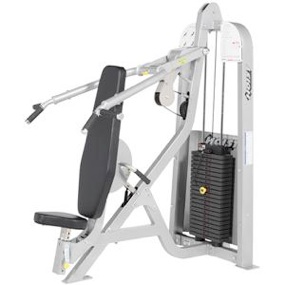
Chest, triceps, and front shoulders
Concerns-don’t fully lock elbows, don’t go beyond chest level when returning preferably couple inches from chest, keep elbows in line with chest, use assistance to get started, if shoulder problems exist don’t bring bar back too far, keep it 3-5 inches from chest, make sure you maintain a neutral position in your low back and neck with abdomen in.
Shoulder presses on multi-press machine
Front shoulders
Concerns-don’t fully lock elbows, don’t go beyond shoulder level when returning preferably couple inches from shoulders, keep elbows out, use assistance to get started if you can, if shoulder problems exist don’t bring bar back too far, keep it 3-5 inches from shoulders and palms facing in grip, make sure you maintain a neutral position in your low back and neck with abdomen in.
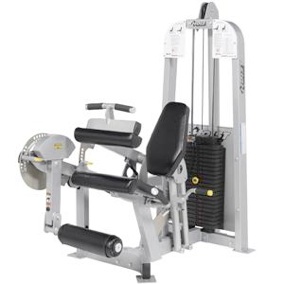
Quadriceps
Concerns-make sure back of knee is brought against seat pad, back is supported at a 90 degree angle, leg shouldn’t go past 90 degrees of knee flexion, don’t fully extend legs there should be at least 5 degrees left in the range of motion, if patellofemoral syndrome exists leg motion should be limited to the last 30 degrees of range of motion in other words from extension to 30 degrees of flexion, if ACL repair or meniscus issues exists leg motion should be limited to 90 degrees of flexion to 60 degrees of flexion-should not approach full extension-short quarter motions. Try to work the vastus medialis (inner knee muscle) by having clients keep toes up and pointed, make sure you maintain a neutral position in your low back and neck with abdomen in.
Seated leg curls-same machine with pad up
Hamstrings
Concerns-try to keep torso still, don’t hyperextend back, make sure back of knee is brought against seat pad, back is supported at a 90 degree angle, leg hold down pad is firm against top of thigh, leg shouldn’t go past 90 degrees of knee flexion, don’t fully extend legs there should be at least 5 degrees left in the range of motion, keep toes up and pointed, make sure you maintain a neutral position in your low back and neck with abdomen in.
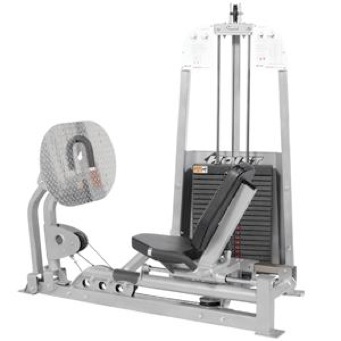
Quadriceps, hamstrings, buttocks, lower back
Concerns-make sure back is supported, stabilize back by performing a drawing in maneuver and hold abdomen in throughout, don’t go to full extensions by locking knees out, feet should maintain contact with platform, don’t bring legs back past 90 degrees of flexion, knees should be in line with feet, you should be able to see toes, make sure you maintain a neutral position in your low back and neck with abdomen in.
Calf raises off leg press
Concerns-make sure back is supported, stabilize back by performing a drawing in maneuver and hold abdomen in throughout, lock knees at a point less than full extension in other words don’t go to full extensions by locking knees out, balls of feet should maintain contact with platform, knees should be in line with feet, try to get a good stretch on the calf muscles, make sure you maintain a neutral position in your low back and neck with abdomen in.
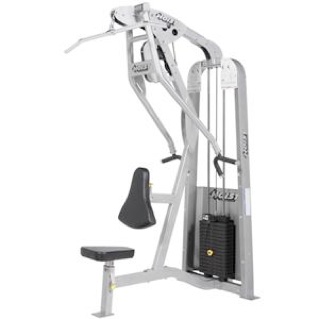
Concerns-try to isolate the muscles between the shoulder blades to prevent shoulder problems, make sure elbows are mirror images of each other, make sure you maintain a neutral position in your low back and neck with abdomen in.
Lat pulldown-upper bar
Concerns-use hand grip that is shoulder width apart, palms can be facing in or out, if shoulder problems exists, such as rotator cuff issues, use a reverse palm facing in grip, pulldown to just below chin and go to almost complete extension, do not hyperextend back or lean backwards too far, make sure you maintain a neutral position in your low back and neck with abdomen in.
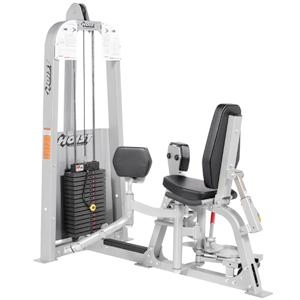
Concerns-make sure back is supported and knees contact pads, have clients focus on the buttocks while performing the motion, concentrate on the outer thigh through steady deliberate motions, keep back against pads at all times, good for individuals with low back problems or replaced hips but be very cautious with limited range of motion, make sure you maintain a neutral position in your low back and neck with abdomen in.
Leg adduction (inner thigh) machine-pads out
Concerns-those with a replaced hip should not perform this exercise, make sure back is supported and knees contact pads, concentrate on the inner thigh through steady deliberate motions, don‘t separate legs too much for there could create a strain to the inner thigh muscles, keep back against pads at all times, make sure you maintain a neutral position in your low back and neck with abdomen in.
Many Exercises can be performed with the Dual Trainer
Basic Upper Body exercises
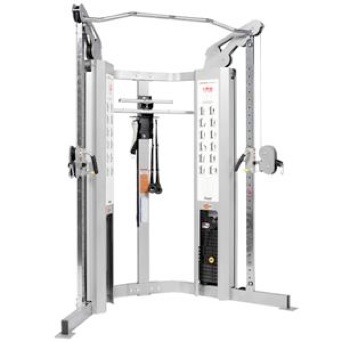
Concerns-perform complete range of motion when performing, don’t jerk and use low back or other muscles during motion, make sure you maintain a neutral position in your low back and neck with abdomen in.
Triceps pushdowns with cable machine
Concerns-perform complete range of motion when performing, don’t jerk and use low back or other muscles during motion, make sure you maintain a neutral position in your low back and neck with abdomen in.
Lateral raise with cable machine
Concerns-don’t go beyond shoulder level especially if shoulder problems
exist, keep elbow bent, elbows should be mirror image of each other, not a good exercise if client has rotator cuff problem, in that case perform band and dumbbell and cable rotator cuff exercises, don’t jerk and use low back or other muscles during motion, make sure you maintain a neutral position in your low back and neck with abdomen in.
Flys or X-overs
Concerns-use assistance to get started, don’t bring pads/handles past chest level, if shoulder problems exist only perform a limited arc of 60 degrees, make sure you maintain a neutral position in your low back and neck with abdomen in.